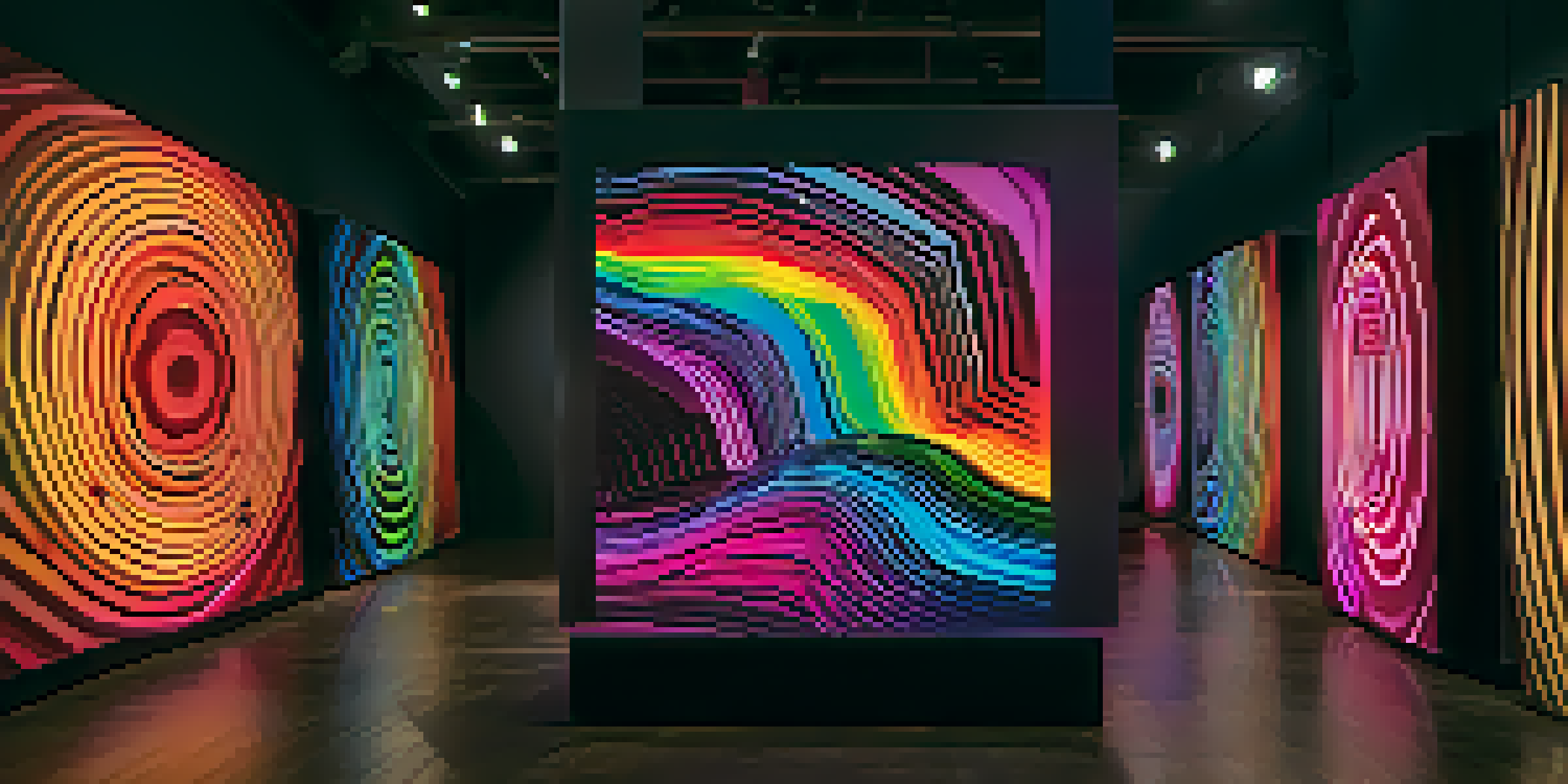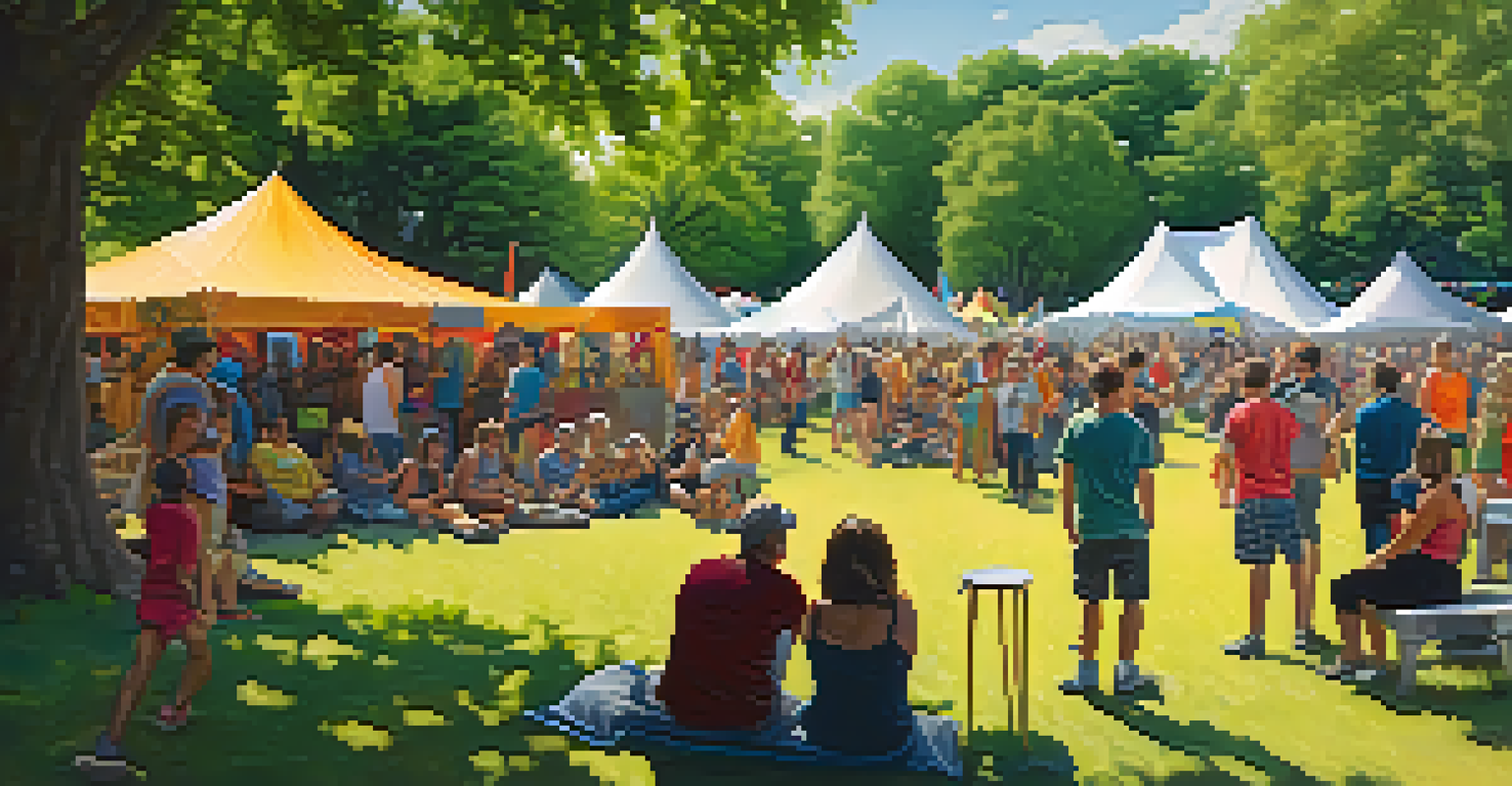Sound Art Festivals: Showcasing the Best of Audio-Visual Art

What is Sound Art and Why It Matters
Sound art is a vibrant and evolving genre that blends auditory experiences with visual elements. Unlike traditional music, sound art emphasizes the exploration of sound itself, often focusing on the relationship between audio and visual stimuli. This unique fusion allows artists to convey emotions and concepts that transcend language, creating a universal dialogue.
Sound is the vocabulary of nature.
In our increasingly digital world, sound art serves as a reminder of the power of sensory experiences. It challenges our perceptions and encourages us to engage with our surroundings in new ways. By showcasing sound as an art medium, festivals highlight the innovative approaches artists are taking to push boundaries and redefine creativity.
Moreover, sound art festivals foster a sense of community among artists and audiences alike. These events provide a platform for experimentation and collaboration, allowing creators to share their work and ideas. This communal spirit enhances the appreciation of sound art, making it accessible to a broader audience.
The Evolution of Sound Art Festivals
Sound art festivals have grown significantly in the past few decades, evolving from niche gatherings to prominent cultural events. Initially, they were often held in underground venues, attracting a select group of enthusiasts. Today, they take place in major cities worldwide, showcasing a diverse array of talent and drawing large crowds.

As technology has advanced, so too has the evolution of sound art festivals. Artists now utilize cutting-edge tools and techniques, such as spatial audio and immersive installations, to create unforgettable experiences. This technological integration not only enhances the artistry but also captivates audiences in ways that were previously unimaginable.
Sound Art: A Unique Creative Fusion
Sound art combines auditory experiences with visual elements, creating a universal dialogue that transcends language.
Furthermore, the rise of social media has played a crucial role in the popularity of these festivals. Artists can now share their work with a global audience, and attendees can connect and engage with each other online. This interconnectedness has helped cultivate a vibrant community centered around sound art, inspiring even more creativity.
Highlighting Notable Sound Art Festivals
There are several notable sound art festivals around the globe that have gained recognition for their innovative programming. One of the most prominent is the 'Sound Art Festival' in Berlin, which features a diverse lineup of installations, live performances, and workshops. This festival attracts artists and audiences from all walks of life, eager to explore the intersection of sound and visual art.
The future of sound is a world of possibilities, where sound can be anything we imagine it to be.
Another prominent festival is the 'Sonar Festival' in Barcelona, celebrated for its pioneering approach to electronic music and sound art. It showcases cutting-edge audiovisual performances that challenge conventional boundaries, making it a must-visit event for enthusiasts. The festival also emphasizes the importance of technology in artistic expression, offering a unique perspective on contemporary sound art.
Additionally, the 'Unsound Festival' in Krakow has garnered attention for its eclectic programming and commitment to experimental sound. This festival brings together a diverse array of artists, creating a rich tapestry of auditory experiences. By fostering collaboration and experimentation, Unsound has become a key player in the global sound art scene.
Experiencing Sound Art: What to Expect
Attending a sound art festival is a unique experience that engages all the senses. Visitors can expect to encounter a variety of installations that challenge their perceptions of sound and space. From immersive environments to interactive performances, each artwork invites exploration and interaction, creating a dynamic atmosphere.
Many festivals also offer workshops and Q&A sessions, allowing attendees to learn directly from the artists. These opportunities foster a deeper understanding of the creative process and the concepts behind the works. Participants often leave these sessions feeling inspired, equipped with new knowledge and a greater appreciation for sound as an art form.
Festivals Foster Community and Innovation
Sound art festivals serve as a platform for collaboration and experimentation, enhancing appreciation for this evolving genre.
Additionally, the festival atmosphere is often buzzing with excitement and collaboration. Artists and attendees mingle, exchanging ideas and experiences, creating a sense of camaraderie. This vibrant community not only enhances the festival experience but also encourages the growth and development of sound art as a whole.
The Role of Technology in Sound Art
Technology plays a pivotal role in the realm of sound art, offering artists new tools to express their creativity. From software that manipulates sound to hardware that captures unique audio experiences, these advancements have transformed the way artists create and present their work. This integration of technology not only enhances the artistic process but also broadens the scope of what is considered sound art.
Moreover, technological innovations have led to the emergence of immersive experiences that engage audiences in novel ways. For example, virtual reality (VR) installations allow viewers to step into an audio-visual landscape, providing a fully immersive experience. This synergy between sound and technology pushes the boundaries of traditional art forms, inviting audiences to engage with art on a deeper level.
As technology continues to evolve, so too will sound art. Artists are constantly exploring new methods and platforms to create and share their work, ensuring that the genre remains fresh and relevant. The marriage of sound and technology not only enhances artistic expression but also fosters innovation within the art community.
The Impact of Sound Art on Culture
Sound art has a profound impact on culture, challenging norms and inspiring dialogue. By blending various artistic disciplines, sound art encourages audiences to experience familiar concepts in unexpected ways. This exploration of sound as a medium invites reflection on societal issues, personal experiences, and cultural narratives.
Festivals play a crucial role in promoting sound art as a legitimate form of expression. They provide a platform for artists to showcase their work while also engaging the public in meaningful conversations about art and culture. Through workshops, discussions, and performances, festivals foster a deeper understanding of the role sound art plays in our lives.
Technology Shapes Sound Art's Future
The integration of advanced technology in sound art allows for immersive experiences, pushing the boundaries of traditional artistic expression.
Furthermore, sound art festivals often highlight local talent, contributing to the cultural richness of their communities. By showcasing emerging artists, these events help cultivate a vibrant arts scene, inspiring future generations to explore creativity. As sound art continues to evolve, its influence on culture and society will undoubtedly persist.
The Future of Sound Art Festivals
As we look to the future, sound art festivals are poised to grow and adapt to an ever-changing landscape. With the emergence of new technologies and artistic practices, these festivals will continue to push boundaries and redefine what sound art can be. Artists will likely explore even more innovative ways to engage audiences, creating experiences that transcend traditional art forms.
Moreover, the ongoing global conversation about sustainability and inclusivity will shape the direction of sound art festivals. Many organizers are already prioritizing eco-friendly practices and diversifying their lineups to create more inclusive environments. This shift will not only enhance the festival experience but also ensure that sound art remains relevant and accessible to all.

Ultimately, the future of sound art festivals lies in their ability to adapt and evolve. By embracing change and fostering creativity, these events will continue to inspire audiences and artists alike. As sound art continues to flourish, we can look forward to a vibrant future filled with innovative experiences and captivating performances.